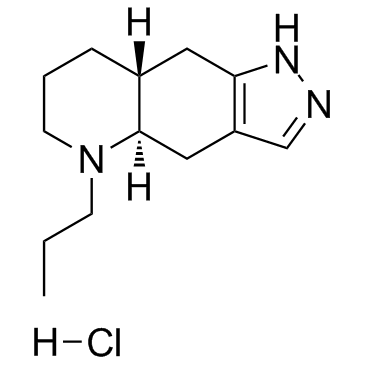(-)-Quinpirole hydrochloride

(-)-Quinpirole hydrochloride structure
|
Common Name | (-)-Quinpirole hydrochloride | ||
|---|---|---|---|---|
| CAS Number | 85798-08-9 | Molecular Weight | 255.78700 | |
| Density | 1.07g/cm3 | Boiling Point | 383.9ºC at 760 mmHg | |
| Molecular Formula | C13H22ClN3 | Melting Point | N/A | |
| MSDS | USA | Flash Point | 186ºC | |
Use of (-)-Quinpirole hydrochlorideQuinpirole (Hydrochloride) is a high-affinity agonist dopamine D2/D3 receptor. |
| Name | (4aR,8aR)-5-propyl-1,4,4a,6,7,8,8a,9-octahydropyrazolo[3,4-g]quinoline,hydrochloride |
|---|---|
| Synonym | More Synonyms |
| Description | Quinpirole (Hydrochloride) is a high-affinity agonist dopamine D2/D3 receptor. |
|---|---|
| Related Catalog | |
| Target |
Dopamine D2/D3 receptor[1]. |
| In Vivo | DA content is left brain biased across groups, and although this asymmetry appears greater in saline controls than all drug-treated groups, there is not a significant interaction between Side and Group. When each side is considered separately it can be seen that in the left brain structure, DA levels progressively decrease with chronic quinpirole treatment, with the QQ rats differing significantly from saline controls. In contrast, right cortical DA levels are only altered significantly (increased) by acute Quinpirole. It can be found that DOPAC levels are also left brain biased across groups. However, no significant Group or interaction effects are found. Rats receiving acute Quinpirole show a selective increase in DA content and decrease in turnover ratio, relative to either saline controls or the QS group. Sensitized (QQ) rats however, have elevated DOPAC levels in comparison to the acute quinpirole group. In striatum as well, all three measures of DA function differed significantly across groups (DA, F3,33=6.27, P=0.0020; DOPAC, F3,33=7.98, P=0.0004; turnover ratio, F3,33=16.85, P<0.0001). In the acute quinpirole rats, both DOPAC and turnover ratio are significantly reduced relative to all other groups. In QQ rats, DOPAC levels are significantly greater than all other groups, while for turnover ratio, both chronic quinpirole groups were increased compared to both chronic saline groups[1]. |
| Animal Admin | Rat[1] 36 male Long-Evans rats are injected daily for 12 days with either saline or Quinpirole (Hydrochloride) (quinpirole HCl: 0.5 mg/kg, s.c., n=18/condition), and placed immediately in Omnitech activity monitors (60×60×40 cm) for 90 min. On the final test day, half the rats in each chronic condition received saline and half Quinpirole (n=9/group). The four groups therefore represented saline controls (SS), acute Quinpirole (SQ), sensitized Quinpirole (no drug)(QS) and sensitized Quinpirole (drug) (QQ). 30 min after the final injection, each rat is removed from the activity monitors to a nearby room and killed immediately by decapitation. This time point is chosen to dissociate the behavioural effects of quinpirole between groups, since acute quinpirole produces inhibition of activity at this time, while chronic quinpirole is associated with pronounced hyperlocomotion at 30 min[1]. |
| References |
| Density | 1.07g/cm3 |
|---|---|
| Boiling Point | 383.9ºC at 760 mmHg |
| Molecular Formula | C13H22ClN3 |
| Molecular Weight | 255.78700 |
| Flash Point | 186ºC |
| Exact Mass | 255.15000 |
| PSA | 31.92000 |
| LogP | 2.73880 |
| Index of Refraction | 1.546 |
CHEMICAL IDENTIFICATION
HEALTH HAZARD DATAACUTE TOXICITY DATA
|
| Personal Protective Equipment | Eyeshields;Gloves;type N95 (US);type P1 (EN143) respirator filter |
|---|---|
| RIDADR | NONH for all modes of transport |
| RTECS | UR0809270 |
|
Chemical genetics reveals a complex functional ground state of neural stem cells.
Nat. Chem. Biol. 3(5) , 268-273, (2007) The identification of self-renewing and multipotent neural stem cells (NSCs) in the mammalian brain holds promise for the treatment of neurological diseases and has yielded new insight into brain canc... |
|
|
Regulation of synaptic MAPK/ERK phosphorylation in the rat striatum and medial prefrontal cortex by dopamine and muscarinic acetylcholine receptors.
J. Neurosci. Res. 93 , 1592-9, (2015) Dopamine and acetylcholine are two principal transmitters in the striatum and are usually balanced to modulate local neural activity and to maintain striatal homeostasis. This study investigates the r... |
|
|
Loss of feedback inhibition via D2 autoreceptors enhances acquisition of cocaine taking and reactivity to drug-paired cues.
Neuropsychopharmacology 40(6) , 1495-509, (2015) A prominent aspect of drug addiction is the ability of drug-associated cues to elicit craving and facilitate relapse. Understanding the factors that regulate cue reactivity will be vital for improving... |
| Anandamide-d4 |
| Quinpirole hydrochloride (USAN) |
| QUINPIROLE HYDROCHLORIDE |
| Quinpirole HCl |